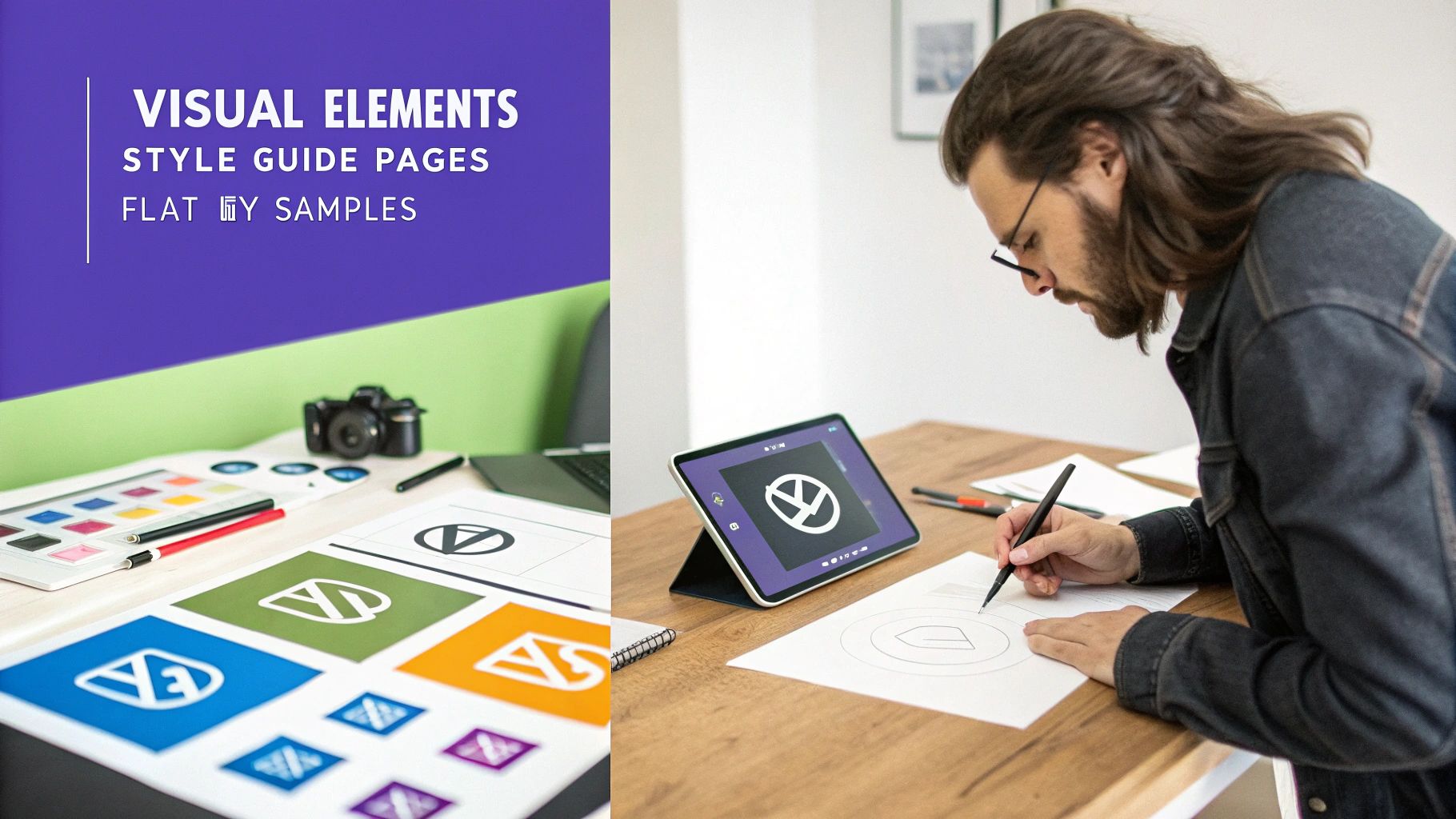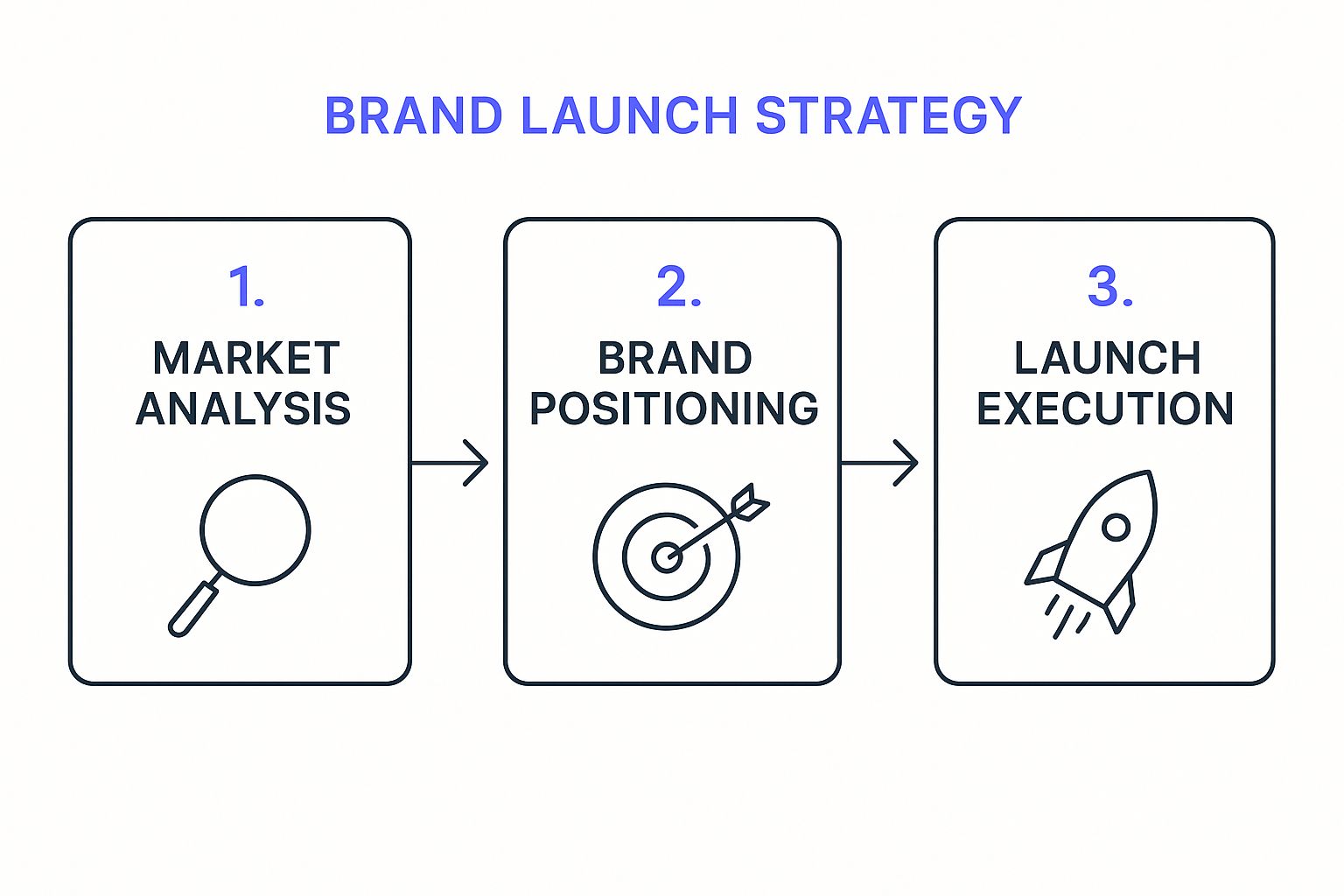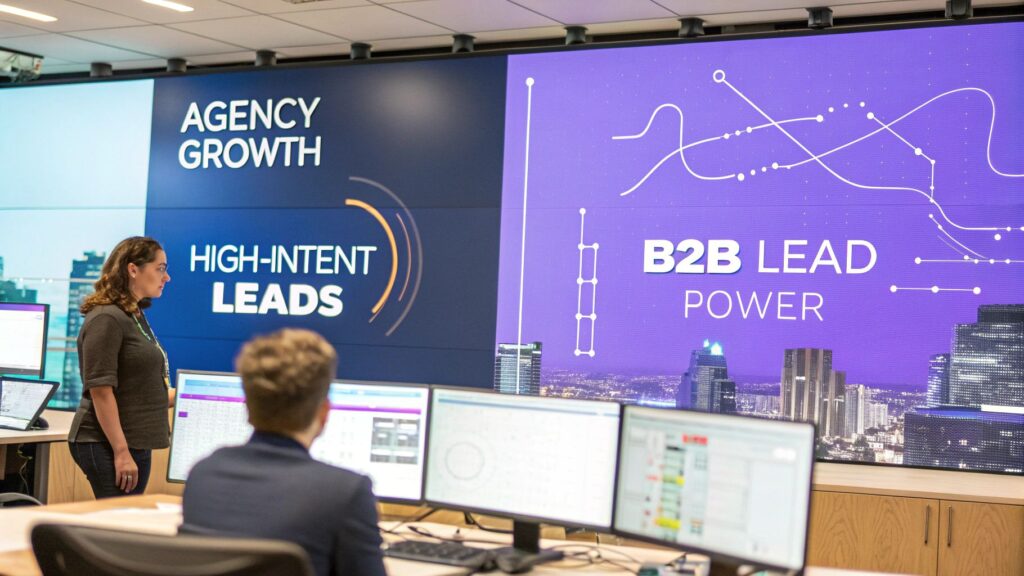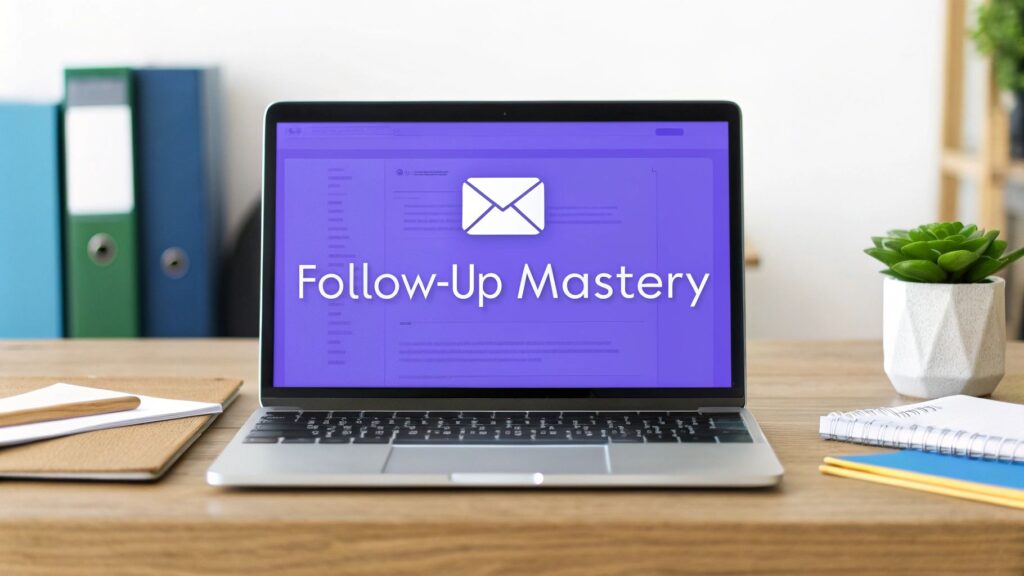Effective Branding Strategy for Startups to Grow Quickly

A modern brand isn't just a slick logo and a clever tagline. It’s built on a foundation of trust and authenticity. For startups, weaving a genuine, purpose-driven story into your company's DNA from day one is the only way to turn one-time buyers into a loyal community that actually roots for you.
Why a Trust-First Approach Is Non-Negotiable

In a market flooded with options, people don't just buy what you do; they buy why you do it. The days of getting by on looks alone are long gone. Today's customers are smart, they're discerning, and they crave a real connection. They want to back companies that share their values—in fact, a study by Stackla found that 86% of consumers say authenticity is a key factor when deciding what brands they like and support.
This shift makes trust the single most valuable currency a new business can have. The data is pretty stark: a staggering 81% of consumers say they need to trust a brand before they'll even think about buying from it. For a startup, this means that building authentic relationships is just as crucial as building a great product.
Crafting Your Authentic Mission and Vision
Your mission and vision statements are not just corporate fluff for your "About Us" page. Think of them as the north star for your entire brand. They should guide every single decision you make, from product development right down to how you answer a customer service email.
- Your Mission: This is your "what" and "how." It clearly spells out what your company does, who you do it for, and how you get it done. A practical example is Patagonia's: "Build the best product, cause no unnecessary harm, use business to inspire and implement solutions to the environmental crisis." It's clear and actionable.
- Your Vision: This is your "why." It's the big, aspirational picture of the future you're working to create. This is what gets your team and your audience fired up. Tesla's vision is "to create the most compelling car company of the 21st century by driving the world's transition to electric vehicles."
Look at a company like Allbirds. They didn't just set out to sell shoes; they sold a vision of a more sustainable future. Their mission was to make better things in a better way, and their vision was to help reverse climate change through smarter business. That powerful story resonated deeply with eco-conscious consumers, building an incredible following long before they were a household name.
A brand is no longer what we tell the consumer it is—it is what consumers tell each other it is. Your job is to give them a story worth sharing.
Turning Purpose Into Connection
You can't fake authenticity. It has to be baked into how your startup operates every single day. Living your mission and vision—not just talking about them—is what builds a real connection.
This means being transparent about your process, owning up to mistakes, and actually listening to your community. A practical insight here is to create a "feedback loop" with early adopters. Use tools like Typeform or even a dedicated Slack channel to solicit honest opinions and show you're building with them, not just for them. These actions are the bedrock of strong client relationships and are essential if you want to turn passive customers into active brand advocates. To really dive deep, check out these proven strategies for building customer trust.
To lay this groundwork, it's helpful to break down the core components of a trust-first brand. These are the pillars that will support everything else you build.
The Core Pillars of Startup Branding
| Pillar | Key Focus | Example Action |
|---|---|---|
| Authenticity | Having a clear purpose and values | Defining and publishing your mission, vision, and core values. |
| Consistency | Delivering a uniform experience | Ensuring your messaging, design, and service are aligned everywhere. |
| Transparency | Being open and honest in all dealings | Sharing behind-the-scenes content or openly discussing challenges. |
| Reliability | Consistently delivering on promises | Setting clear customer expectations and meeting them every time. |
Ultimately, building a strong brand isn't about getting recognized; it's about building a solid reputation. When you start with a foundation of trust, you create a brand that can handle market shifts and build lasting connections with your audience. That’s the real key to moving beyond simple transactions and toward sustainable growth. For a deeper look, check out our guide on how to https://fundediq.co/how-to-build-client-relationships/.
Finding Your Place in a Crowded Market

It’s a tough truth: even a brilliant product can get lost in the noise. Today’s customers are swimming in a sea of marketing messages, and if you don’t give them a clear reason to pay attention, they won’t. Simply showing up isn't a strategy. Research from McKinsey shows that high-growth brands are 60% more likely to have a well-defined brand positioning.
This is where brand positioning comes in. It’s the art of deliberately carving out a distinct and memorable space in your customers' minds. Without it, you're just another option, easily overlooked and forgotten. This isn't about having the flashiest ads; it's about defining your territory and proving you're the only real choice for a specific kind of person.
Deconstructing the Competition to Find Your Opening
Before you can plant your flag, you need a map of the existing terrain. Think of competitor analysis as a form of brand reconnaissance. You’re not just making a list of rivals; you're looking for the gaps they've left wide open.
Start by identifying your top direct and indirect competitors. Go beyond their feature lists and really dissect their brand messaging. A practical way to do this is with a simple spreadsheet. Create columns for Brand Name, Key Messaging, Target Audience, and Brand Voice. After analyzing 5-10 competitors, you'll start to see patterns and, more importantly, weaknesses. What promises are they making (or breaking)? What emotions are they trying to connect with?
Your competitive edge isn't just about being different—it's about being uniquely valuable to an audience that others are either underserving or ignoring completely.
Look for the patterns, but more importantly, look for the weaknesses. Maybe all your competitors are chasing enterprise contracts, leaving a huge opening with small businesses. Or perhaps they're all locked in a feature war, while no one is even attempting to offer incredible, human-powered customer support. These are your entry points. A classic example is Dollar Shave Club, which entered a market dominated by Gillette by focusing on price, convenience, and a humorous, anti-establishment brand voice—a gap the incumbents had completely ignored.
Moving Beyond Demographics to True Customer Understanding
Knowing your market is table stakes. Truly understanding your customer is the whole game. This is where so many startups miss the mark, getting stuck on generic demographics instead of digging for real human insights. The goal here is to build out customer personas that feel like actual people with real-world problems.
These personas are essentially fictional profiles of your ideal customers, pieced together from research, interviews, and data. They need to go way beyond age and location to capture what truly drives them.
- Pain Points: What's the specific problem that keeps them up at night? What are the biggest frustrations they face that you can help eliminate?
- Goals and Aspirations: What does a "win" look like for them? What are they ultimately trying to accomplish, and how can your brand be the catalyst?
- Decision Triggers: What event or feeling makes them finally start looking for a solution like yours? What do they need to see or hear to feel confident in their choice?
For example, a project management tool isn't just for "managers aged 30-50." A much sharper persona is "Maria, the Overwhelmed Agency Owner," who is constantly battling disorganized client feedback and missed deadlines, and whose biggest goal is just to reclaim her evenings. That's the level of detail that lets you create a message that actually lands. If you want to dive deeper, our guide on how to create buyer personas is a great resource.
Crafting a Powerful Positioning Statement
Once you’ve got a clear view of the market gap and a genuine understanding of your ideal customer, you can distill it all into a powerful positioning statement. This isn't a tagline for your website; it's an internal compass—a concise declaration of your unique place in the market that will guide every decision you make.
A solid positioning statement usually follows this simple, effective formula:
For [Target Customer] who [has a specific need or problem], [Your Brand] is the [Category/Industry] that provides [Key Benefit/Point of Difference] because [Reason to Believe].
Let’s put this into practice with a fictional startup, "SyncFlow," a tool for creative teams.
- Target: For remote creative agencies…
- Need: …who struggle with chaotic feedback loops on visual projects…
- Brand/Category: …SyncFlow is the collaborative review platform…
- Benefit: …that centralizes all comments directly on the creative assets…
- Reason: …because it integrates seamlessly with their existing design software.
This statement immediately defines who SyncFlow is for, the exact pain it solves, and why it’s a smarter choice than a generic alternative like email. This isn't just a word puzzle; it’s the strategic foundation that ensures every marketing email, sales pitch, and product update works together to help you own your niche.
Building Your Brand's Look and Feel
Alright, you've done the hard strategic work. You know who you are, who you're for, and what makes you different. Now for the fun part: bringing that strategy to life with a look, a feel, and a voice. This is where your brand gets its personality—the tangible stuff people can see, hear, and connect with.
Think of it as the sensory shortcut to your brand's soul. When done right, it's incredibly powerful. In fact, presenting your brand consistently across all platforms can boost revenue by a whopping 33%. This isn't just about looking good; it's a core piece of any smart branding strategy for startups.
It's So Much More Than a Logo
Everyone wants to jump straight to the logo, and I get it. It's the visual anchor. But a logo is just one player on a much bigger team. A truly strong brand identity is a complete system where every element works together, ensuring you show up as the same brand no matter where people find you.
What's in this system?
- Brand Name: The first thing people will learn. It needs to be memorable, easy to say, and hopefully give a little hint about what you're all about.
- Logo: A versatile, hardworking symbol that looks just as good as a tiny favicon on a browser tab as it does on a massive billboard.
- Color Palette: A curated set of colors that trigger the right emotions. This isn't just about picking your favorites; it's about strategic communication.
- Typography: The specific fonts you'll use for everything from headlines to body copy. They set the mood and make your words easier (or harder) to read.
- Voice and Tone: How you sound. Are you a witty friend, a trusted advisor, or a formal expert? This needs to be defined.
Finding a Name That Sticks
Your brand name is arguably your most permanent marketing decision. It’s a huge asset. It’s what people will type into Google, say to their friends, and remember (or forget). The right name feels distinctive, is easy to recall, and—critically—is actually available.
When you're brainstorming, think about the different routes you can take. Some brands are descriptive (The Weather Channel tells you exactly what it is). Others are more evocative, suggesting a feeling or benefit (think of how "Nest" makes you feel safe and at home). Then you have invented names like Kodak or abstract ones like Apple.
The real key is picking a name that doesn't box you in. A practical insight is to test your top 3-5 names with a small group of your target audience. Ask them what comes to mind when they hear it and how easy it is to spell after hearing it once. This simple test can save you from a major headache down the road.
A brand name is the hook you hang your story on. It should be simple enough to remember but have enough depth to carry some real meaning.
Designing a Strategic Visual System
Colors and fonts are silent communicators. They're doing a lot of heavy lifting on a subconscious level, long before anyone reads a single word. Color psychology is a very real thing. Studies show that color can increase brand recognition by up to 80%. Blue often signals trust and dependability (hello, [IBM]), while green can bring to mind health, nature, or growth (like Whole Foods).
Typography works the same way. A clean, modern sans-serif font like Helvetica can feel efficient and minimalist. A classic serif font like Garamond, on the other hand, can feel more traditional, established, and trustworthy. Your choice here instantly frames how people perceive your words.
Real-World Example: Slack
Let's look at Slack. Their brand identity is a masterclass in this. It's so much more than that colorful little hashtag logo. The playful color palette, the friendly and rounded typography, and that incredibly distinct voice—helpful, a little witty, never robotic—all come together perfectly.
It makes the product feel less like a sterile corporate tool and more like a helpful teammate. Ever read their release notes? They're often filled with charming little stories. That's a brand living its personality in every single detail, creating a consistent and recognizable experience.
Defining Your Voice and Tone
How you say things is just as important as what you're saying. Here's a simple way to think about it: your brand voice is your fixed personality, while your tone changes depending on the situation.
For example, your voice might always be "empowering." But your tone will shift. On a blog post, it might be "inspirational." In a support ticket reply to a frustrated customer, it will need to be "reassuring" and "calm."
A great first step is to simply brainstorm some adjectives. What is your brand?
- Playful or Serious?
- Formal or Casual?
- Modern or Traditional?
- Energetic or Calm?
Write these down. Create a simple guide. This is how you get everyone on your team, from the person running your social media to the engineer writing error messages, to sound like they're all part of the same company. A practical way to implement this is to include a "This, Not That" section in your guide. For example: "We are Confident, not Arrogant." This provides clear guardrails for your team.
Using AI to Create Deeper Customer Connections

Let’s be honest: personalization isn’t a nice-to-have anymore. It’s the ticket to the game. Your customers are bombarded with generic, one-size-fits-all messages every day, and most of it just becomes noise.
This is where artificial intelligence stops being some futuristic concept and becomes a startup’s best friend. It’s the tool that helps you build genuine, meaningful relationships with the people you want to serve.
You don’t need a team of data scientists on payroll to make this work, either. Modern AI tools are surprisingly accessible, giving you the power to understand and connect with your audience on a truly individual level. When you can create an experience that feels like it was made just for them, you’re not just selling a product—you’re building a brand people feel connected to.
The proof is in the numbers. A staggering 75% of consumers say they’re more likely to buy from a brand that actually personalizes their experience. For a startup, this means AI isn't just about working faster; it's about connecting better and building the kind of loyalty that turns customers into advocates. You can dig deeper into emerging branding trends over at The Branding Journal.
Generating Hyper-Relevant Content at Scale
So where do you start? Content is one of the most immediate places AI can make a huge impact. These platforms can chew through your customer data—things like past purchases, what they looked at on your site, and how they’ve engaged with you before—to whip up marketing copy that speaks their language.
Think about an e-commerce startup. Instead of blasting out a generic "New Arrivals" email, AI can create countless variations on the fly. One group of customers might see an email focused on sustainable products because they’ve bought eco-friendly items before. Another might get a subject line about new running gear. This is hyper-personalization in action. A real-world example is Netflix, which uses AI to personalize not just movie recommendations but even the thumbnail images you see, testing which visuals are most likely to make you click.
This screenshot from HubSpot’s marketing statistics shows just how common this has become.

Marketers are clearly leaning on AI not just to be more efficient, but to create flat-out better content. It's a clear signal that the game has shifted toward data-informed, personalized strategies.
Uncovering Hidden Insights in Your Data
Beyond writing copy, AI is an absolute beast at analysis. Your startup is probably sitting on a goldmine of data from your website, CRM, and social media feeds. AI tools are built to sift through all that information and spot patterns a human eye would almost certainly miss.
For example, an AI analytics tool might notice that your highest-value customers in Texas almost always interact with your Instagram stories right before making a purchase. Boom. That's a powerful insight. Now you know exactly where to double down with targeted content to reach that specific audience, making every marketing dollar work harder.
The real magic of AI in branding isn't just automation; it's augmentation. It gives a small team the analytical horsepower of a massive corporation, helping you make smarter, faster, and more empathetic decisions.
You can finally move from making educated guesses to making truly data-driven choices about your brand’s messaging and how you guide customers through their journey with you.
Practical AI Applications for Startups
Getting started with AI-driven personalization doesn't have to break the bank. There are plenty of accessible tools that can help you put these ideas into action right away.
Here are a few practical ways to get going:
- Dynamic Website Content: Use tools like Optimizely or Google Optimize that automatically change your website’s headlines, images, or calls-to-action based on who’s visiting. A first-timer could see a welcome discount, while a returning customer sees recommendations based on their last order.
- Personalized Email Campaigns: Go way beyond just using a customer's first name. Platforms like Klaviyo use AI to help you slice your audience into tiny, hyper-specific segments and send them offers and content that are incredibly relevant to their individual interests.
- Chatbot-Powered Support: A smart chatbot on your site like Intercom or Drift can handle common questions 24/7. More advanced bots can even tap into customer history to give personalized help, like an order status update or product suggestions tailored to them.
When you thoughtfully weave these technologies into your strategy, you create a brand experience that feels attentive, helpful, and, most importantly, human. This is how a nimble startup can punch far above its weight, building the kind of deep connections that larger, slower competitors just can't match.
Launching and Managing Your Brand for Growth
You’ve done the hard work of building the strategic foundation and crafting a memorable identity. Now comes the exciting part: moving from planning to action. A powerful brand doesn't just end with a great logo; its life truly begins with a successful launch and is sustained through careful, consistent management.
This is the moment your brand finally meets the real world. A well-planned launch can create a wave of momentum that will carry your startup for months. But without consistent management, that energy can fizzle out just as quickly as you scale. The key is to build a system that protects your brand's integrity while giving it the space it needs to grow and adapt.
This visual breakdown shows the core sequence for a strategic brand rollout, starting from the initial analysis and culminating in the final execution.

What this really drives home is that a successful launch isn't the starting line. It's the final, crucial step in a much larger strategic process.
Creating Your Brand's Single Source of Truth
Before you even dream of a public announcement, you need to create your brand style guide. Think of this document as your brand’s bible. It's the single source of truth that ensures everyone—from your co-founder to a freelance designer you hired last week—represents your company with absolute consistency.
Inconsistency is a brand killer. It breeds confusion and erodes trust before you've even had a chance to build it. A practical insight is to host this guide on a platform like Notion or a shared Google Doc, making it a living document that's easily accessible to the entire team.
Your style guide should be a practical, easy-to-use resource that covers all the essentials. Don't overcomplicate it, but be thorough.
- Logo Usage: Lay down clear rules for how your logo should be used. Include minimum sizes, clear space requirements, and a simple list of "don'ts," like never stretching or recoloring it.
- Color Palette: Define your primary and secondary colors with their exact hex codes. Be specific about which colors are for backgrounds, text, and call-to-action buttons.
- Typography: Name the specific fonts for headlines, subheadings, and body text. Include guidelines for weights and sizing for both web and print.
- Voice and Tone: This is crucial. Describe your brand's personality and explain how it should sound in different situations, like on a casual social media post versus a formal support email.
And this isn't just for designers. Your sales team needs it for their slide decks, and your marketing team needs it for every single piece of content they produce. It’s the tool that makes brand consistency possible.
Architecting a Phased Brand Launch
While a "big bang" launch can certainly make a splash, a phased approach often builds more sustainable momentum and lowers your risk. It’s less like one giant cannonball and more like a series of controlled, powerful waves.
1. The Internal Rollout (Soft Launch): Always start with your own team. Get them excited and turn them into your very first brand ambassadors. They need to understand the story, believe in the mission, and know exactly how to talk about the brand consistently.
2. The Beta Launch (Exclusive Preview): Next, introduce the new brand to a select group of loyal customers or trusted industry insiders. This creates a sense of exclusivity and, more importantly, gives you a chance to gather priceless feedback before you go wide.
3. The Public Launch (Main Event): This is your big reveal. Coordinate everything to happen at once across all your channels—a press release, a completely new website experience, social media announcements, and an email blast to your entire list. The goal is a concentrated burst of activity that your target audience simply can't miss.
A successful brand launch isn't just an announcement. It's a carefully choreographed story that unfolds over time, building anticipation and turning your audience into active participants.
The Ongoing Work of Brand Management
Launching is just a moment in time. The real work is managing and nurturing your brand day in and day out as your startup grows and the market inevitably shifts. Brand management is an active, ongoing process, not a task you check off a list. As you navigate this, understanding how to adjust your online brand in the digital world is especially critical.
This continuous effort means monitoring how customers perceive you through social listening and surveys, ensuring all new marketing materials are perfectly on-brand, and regularly auditing your presence across every platform. A huge part of this is also using targeted stories to reinforce who you are. To dive deeper, check out our guide to https://fundediq.co/content-marketing-for-startups/ to see how powerful storytelling supports long-term brand health.
Staying vigilant allows you to catch inconsistencies before they become real problems. It also gives you the data you need to make smart decisions about when it’s time to evolve your brand, whether that’s a minor messaging tweak or a full-blown rebrand.
A structured checklist can make sure nothing falls through the cracks during this critical period.
Your Brand Launch Checklist
Here’s a simple checklist to guide you through the key phases of a successful brand launch, ensuring all your bases are covered from internal prep to public reveal.
| Phase | Key Tasks | Success Metric |
|---|---|---|
| Pre-Launch | Finalize style guide. Prepare all launch assets (website, social, etc.). Train internal team on new brand messaging. | 100% of launch assets are on-brand. Team members can articulate the brand mission. |
| Soft Launch | Share new brand with a select group of customers/partners. Gather feedback via surveys or interviews. | Positive sentiment from beta testers. At least 10 actionable feedback points collected. |
| Public Launch | Execute coordinated multi-channel announcement. Distribute press release to media contacts. Launch new website. | >20% increase in website traffic in the first week. Media mentions in 3-5 relevant publications. |
| Post-Launch | Monitor social media mentions and brand sentiment. Track key marketing and sales metrics. Follow up with media contacts. | Maintain a positive sentiment score above 80%. Achieve a 15% lift in lead generation post-launch. |
Using this framework helps you move methodically, turning a potentially chaotic process into a well-orchestrated event that sets your startup up for lasting success.
Answering Your Toughest Branding Questions
No matter how airtight your plan is, you're going to have questions. That's just part of the process. A smart branding strategy isn't just about the creative brief; it's about knowing what to do when you hit those inevitable bumps in the road.
I've been in these trenches with founders countless times, so let's tackle the questions that come up most often. Think of this as a quick FAQ to clear up any confusion, from figuring out the budget to trying to measure something that feels intangible.
How Much Should a Startup Really Spend on Branding?
Everyone wants a magic number, but it doesn't exist. The classic rule of thumb says B2B startups should set aside 2-5% of their projected revenue for marketing, with branding being a key piece of that pie. For B2C companies fighting for consumer attention, that number often climbs to 5-10%.
But let's be realistic—your startup's stage is what really dictates the budget.
- Pre-Seed/Seed Stage: At this point, your budget is more about sweat equity than cash. Your focus should be on getting the foundations right: your positioning, core messaging, and a basic visual identity. A practical budget for a professional logo and a simple brand guide might range from $2,000 to $10,000.
- Series A and Beyond: Once you've found product-market fit, it's time to double down. This is when you bring in the pros for a comprehensive brand identity system, detailed style guides, and bigger campaigns to build awareness. Budgets here can range from $25,000 to over $100,000 for a full agency-led process.
The most important shift in mindset is to see branding as an investment, not just another line item on your expense report. A strong brand becomes a long-term asset that makes everything else—especially customer acquisition—cheaper and easier over time.
Treat branding like an appreciating asset, not a one-time cost. Every ounce of effort you put into building a clear, consistent brand pays you back in customer trust and market recognition for years to come.
How Do I Actually Measure the ROI of Branding?
This is the big one. Measuring the return on your branding efforts can feel like trying to nail Jell-O to a wall, but it's far from impossible. You just need to know what to look for. While you can't always draw a perfectly straight line from a new logo to a new sale, you can absolutely track its influence.
After you launch a new brand or a major campaign, keep a close eye on these key metrics:
- Direct Traffic: Are more people typing your URL directly into their browser? Use Google Analytics to track this. A steady increase is a fantastic indicator of growing brand recall.
- Branded Search Volume: An uptick in people Googling your company's name is one of the strongest signals that your awareness efforts are working. You can monitor this with tools like SEMrush or Google Search Console.
- Social Media Engagement: Don't just look at follower counts. Are people sharing, commenting, and talking about your brand? Track your "Share of Voice"—the percentage of mentions your brand gets compared to competitors.
- Customer Feedback & Surveys: Just ask! Use tools like the Net Promoter Score (NPS) to get direct feedback on how customers perceive your brand and whether that perception is changing.
By connecting these dots, you can build a compelling case for how your brand is directly impacting business growth.
When Is It the Right Time for a Rebrand?
Let's get one thing straight: a rebrand is major surgery, not a quick cosmetic fix for a slump in sales. You should only pull this trigger for very specific, strategic reasons.
So, when does it make sense?
- Your entire business model has changed. If you've pivoted from a simple consumer app to a complex enterprise SaaS platform, your old brand probably doesn't fit anymore. A prime example is Instagram, which evolved its skeuomorphic, Polaroid-style logo to a simple, flat design that reflected its new status as a modern media powerhouse, not just a photo-filter app.
- You're moving into completely new markets. A brand name or visual style that works perfectly in North America might fall flat—or worse, be offensive—in another culture.
- Your brand just looks old and out of touch. If your visual identity screams 2010, it sends a subtle signal to customers that your product might be just as dated.
At the end of the day, it all comes back to the story you're telling. The data doesn't lie: around 68% of consumers report that brand stories influence their buying decisions. This is a powerful reminder, backed by insights from resources like HubSpot's marketing statistics, that startups live and die by the authenticity of their narrative.
Ready to find your next high-intent leads? FundedIQ delivers hand-curated lists of recently funded startups, complete with verified decision-maker contacts. Stop guessing and start engaging with companies actively looking to grow. Visit https://fundediq.co to see how we can accelerate your deal flow today.





